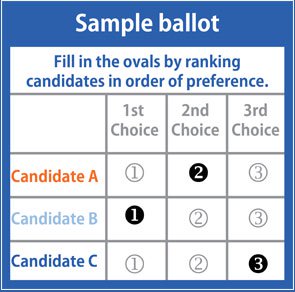Boca Raton can join Sarasota in becoming one of the first Florida cities to implement a new way of voting. Ranked-Choice Voting is the way city governments can better reflect voter’s desires.

If an election is supposed to reflect voter’s views why are we using a flawed system to elect members to the City Council?
Under the plurality rule voting system predominant in our country, each citizen votes for a single candidate, and the candidate with the most votes wins, even if that candidate falls short of a majority.
How Ranked Choice Voting Works
The August 28th election to fill seat A on the Boca City Council was contested by Kathy Cottrell, Tamara McKee, and Andy Thomson. Three days after the polls closed, Thomson was declared the winner with 7,927 votes. Cottrell earned 7,897, and McKee came in third with 2,133. By being ‘first past the post’ (although barely), Thomson was declared the winner with 44% of the votes. To put it somewhat more harshly 56% of the voters did not want Thomson to represent them on seat A.
Plurality voting only tells us what each voter thinks about just one candidate, while ignoring their opinions about everybody else. A Ranked-Choice Voting System (RCV) would remedy these flaws by allowing voters to rank candidates in order of preference. RCV allows voters to number the candidates on their ballot and their alternate choices come into play if no candidate receives the majority (50 percent plus 1) of first preferences.
If that happens, the candidate with the fewest votes is eliminated, and their votes redistributed to whomever those voters ranked second. Eliminating the candidate with the fewest votes would also effectively marginalize the ‘spoiler’ candidate (a ‘spoiler’ being a candidate who cannot win but whose presence on the ballot affects which candidate does win)
It’s Happening Elsewhere
Ranked-Choice Voting is currently the preferred electoral methodology in:
- Basalt, Colorado: Adopted in 2002 and will be used when three or more candidates run for mayor.
- Berkeley, California: Adopted in 2004 and has been used since 2010 to elect the mayor, city council and city auditor
- Cambridge, Massachusetts: In use since the 1940s in multi-winner RCV form for the nine-seat city council and six seat school board elected citywide
- Carbondale, Colorado: Adopted in 2002 for mayor when there are three or more candidates
- Minneapolis, Minnesota: Adopted in 2006 and used since 2009, in elections for 22 city offices, including mayor and city council in single winner elections and some multi-winner park board seats
- Oakland, California: Adopted in 2006 and used since 2010 for a total of 18 city offices, including mayor and city council
- Portland, Maine: Adopted in 2010 and first used in 2011 and 2015 for electing mayor
- Maine: Adopted in 2016 and first used in June 2018 for all state and federal primary elections
- San Francisco, California: Adopted in 2002 and used since 2004 to elect the mayor, city attorney, Board of Supervisors and five additional citywide offices
- San Leandro, California: Adopted as option in 2000 charter amendment and used since 2010 to elect the mayor and city council
- Santa Fe, New Mexico: Adopted in 2008 and used since March 2018 for mayor, city council, and municipal judge
- St. Paul, Minnesota: Adopted in 2009, used since 2011 to elect the mayor and city council
- Takoma Park, Maryland: Adopted in 2006 and used since 2007 in all elections for mayor and city council
- Telluride, Colorado: Adopted in 2008 and used since 2011 to elect the mayor when three candidates run, as in 2011 and 2015
In the meantime, Maine made history on Tuesday, Nov. 6 by becoming the first state to elect a U.S. Senator and two members of the U.S. House of Representatives using Ranked-Choice Voting. Election officials throughout the state reported that the RCV election went smoothly, and Secretary of State Matt Dunlap was quoted as saying that “overall, voters were pleased with it” and that he expects RCV to become a “fixture” of Maine politics.
Ranked choice voting can make the local electoral process fairer and more functional. It is a simple change that would more clearly reflect the preferences of the voter.
Having said that, we can expect ranked choice voting to be vigorously opposed by those whose special interests are best served by fielding spoiler candidates.

